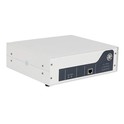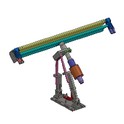What is the Descaling Efficiency of a 500W Ultrasonic Generator?
As a supplier of 500W ultrasonic generators, I am often asked about the descaling efficiency of these devices. In this blog post, I will delve into the factors that influence the descaling efficiency of a 500W ultrasonic generator and provide insights into how it compares to other power - rated ultrasonic generators.
How Ultrasonic Descaling Works
Before discussing the descaling efficiency, it's essential to understand the principle behind ultrasonic descaling. Ultrasonic generators produce high - frequency electrical signals that are converted into mechanical vibrations by a transducer. These vibrations create ultrasonic waves in a liquid medium, typically water. The ultrasonic waves generate a phenomenon called cavitation. Cavitation occurs when tiny bubbles form and collapse rapidly in the liquid. The implosion of these bubbles creates intense shockwaves and micro - jets, which can dislodge scale deposits from surfaces.
Factors Affecting Descaling Efficiency
- Power Output: The power of an ultrasonic generator plays a crucial role in descaling efficiency. A 500W ultrasonic generator provides a certain level of energy to the liquid medium. Higher power generally means more intense cavitation and potentially faster descaling. However, power is not the only factor. A 500W generator can be highly effective in descaling applications where the scale is not overly thick or stubborn.
- Frequency: The frequency of the ultrasonic waves also impacts descaling efficiency. Different frequencies are suitable for different types of scale and materials. Lower frequencies (e.g., 20 - 40 kHz) tend to produce larger cavitation bubbles, which are more effective for removing thick and hard scale deposits. Higher frequencies (e.g., 80 - 100 kHz) generate smaller bubbles, which are better for more delicate cleaning and removing thin scale layers. Most 500W ultrasonic generators offer a range of frequencies to adapt to various descaling needs.
- Scale Type and Thickness: The type of scale, such as calcium carbonate, magnesium hydroxide, or iron oxide, and its thickness significantly affect the descaling process. Soft and thin scale deposits are easier to remove compared to hard and thick ones. A 500W ultrasonic generator can efficiently remove thin scale layers in a relatively short time. For thicker scale, it may take longer or require multiple descaling cycles.
- Liquid Medium: The properties of the liquid medium, such as its viscosity, temperature, and chemical composition, also influence descaling efficiency. For example, warmer liquids generally enhance cavitation, leading to better descaling results. Some additives can be added to the liquid to improve the solubility of scale and boost the descaling process.
Advantages of a 500W Ultrasonic Generator in Descaling
- Energy Efficiency: Compared to higher - power ultrasonic generators, a 500W unit consumes less electricity. This makes it a cost - effective option for small - to - medium - scale descaling applications, such as in household appliances, small industrial equipment, or laboratory instruments.
- Versatility: A 500W ultrasonic generator can be used in a wide range of applications. It can be applied to descale pipes, heat exchangers, filters, and various metal and non - metal surfaces. Its relatively compact size and moderate power make it suitable for both on - site and in - house descaling operations.
- Safety: With lower power, a 500W ultrasonic generator is generally safer to operate. It reduces the risk of overheating and electrical hazards, making it a more user - friendly option, especially for operators with less technical expertise.
Comparison with Other Power - Rated Ultrasonic Generators
- 1000W Ultrasonic Generator: A 1000W Ultrasonic Generator provides more power than a 500W unit. This additional power can result in more rapid descaling, especially for thick and stubborn scale deposits. However, it also consumes more energy and may be larger in size. For applications where time is of the essence and scale is particularly challenging, a 1000W generator may be a better choice.
- 2000W Ultrasonic Generator: The 2000W Ultrasonic Generator offers even higher power. It is suitable for large - scale industrial descaling applications, such as in power plants, refineries, and large manufacturing facilities. The increased power can handle large - volume descaling tasks quickly, but it comes with a higher cost in terms of energy consumption and equipment investment.
- 3000W Ultrasonic Generator: A 3000W Ultrasonic Generator is designed for the most demanding descaling jobs. It can descale large - diameter pipes, heavy - duty industrial equipment, and structures with extremely thick scale. However, its high power requirements and large size make it less suitable for small - scale or domestic applications.
Measuring Descaling Efficiency
To accurately measure the descaling efficiency of a 500W ultrasonic generator, several methods can be used. One common approach is to measure the weight of the scale before and after descaling. The percentage reduction in scale weight indicates the descaling efficiency. Another method is to use visual inspection or non - destructive testing techniques, such as ultrasonic thickness gauges or eddy - current testing, to assess the remaining scale thickness on the surface.
Real - World Applications and Case Studies
In the food and beverage industry, a 500W ultrasonic generator can be used to descale heat exchangers and pipes. For example, in a dairy processing plant, the scale formed by milk solids and minerals can be effectively removed using a 500W unit, ensuring the smooth operation of the equipment and maintaining product quality.
In the automotive industry, it can be applied to descale engine cooling systems. The scale in the radiator and coolant pipes can reduce the cooling efficiency, and a 500W ultrasonic generator can help restore the system's performance.
Conclusion
The descaling efficiency of a 500W ultrasonic generator is influenced by multiple factors, including power output, frequency, scale type and thickness, and the liquid medium. While it may not be as powerful as higher - rated generators, it offers energy efficiency, versatility, and safety advantages. It is well - suited for small - to - medium - scale descaling applications in various industries.


If you are interested in learning more about our 500W ultrasonic generators or other power - rated models for your specific descaling needs, please feel free to contact us for procurement and further discussion. We are committed to providing high - quality ultrasonic solutions to meet your requirements.
References
- "Ultrasonic Cleaning: Fundamentals and New Developments" by Dr. J. Wei
- "Industrial Applications of Ultrasonics" edited by Dr. R. C. Cheung
- Technical literature on ultrasonic generator performance from leading manufacturers in the industry.






